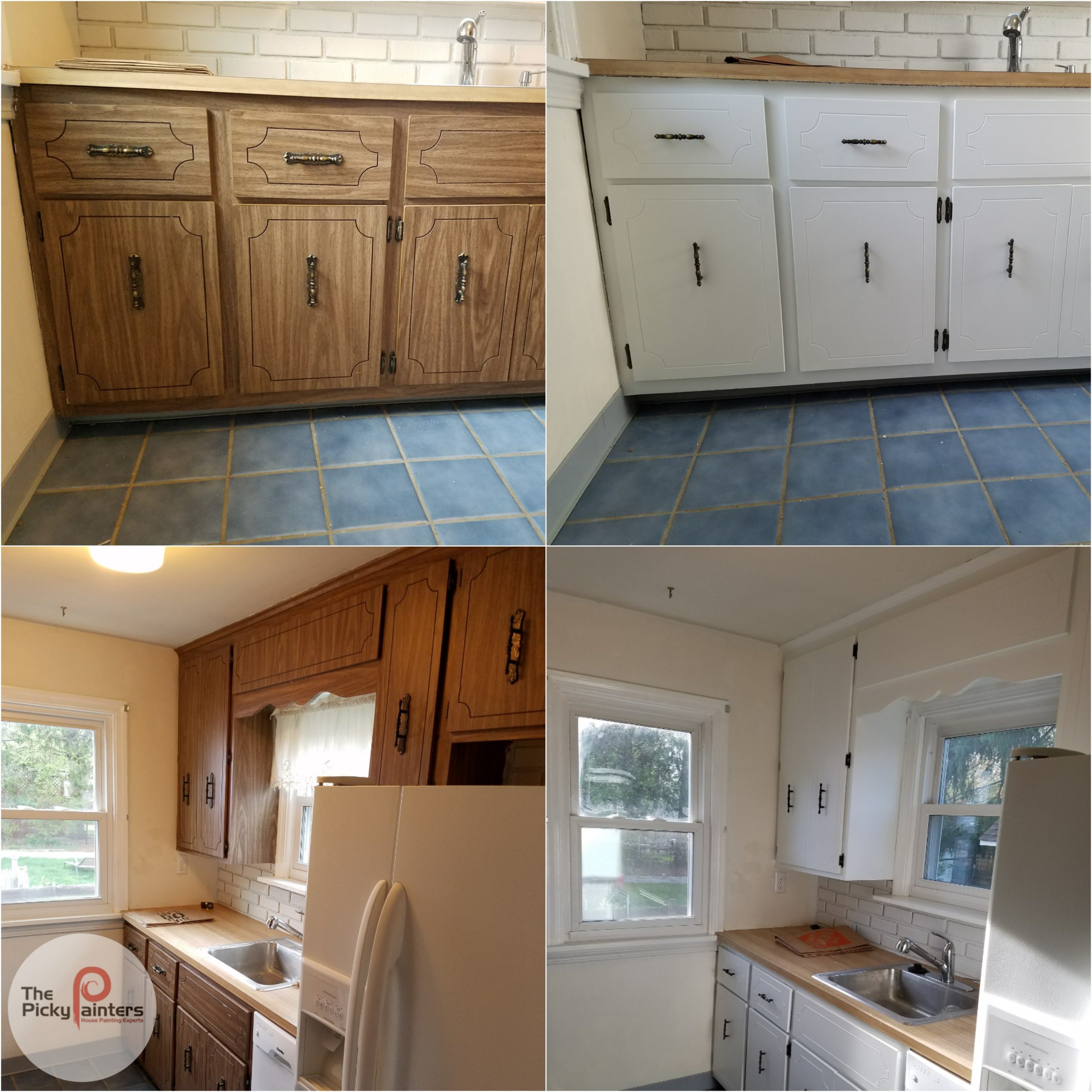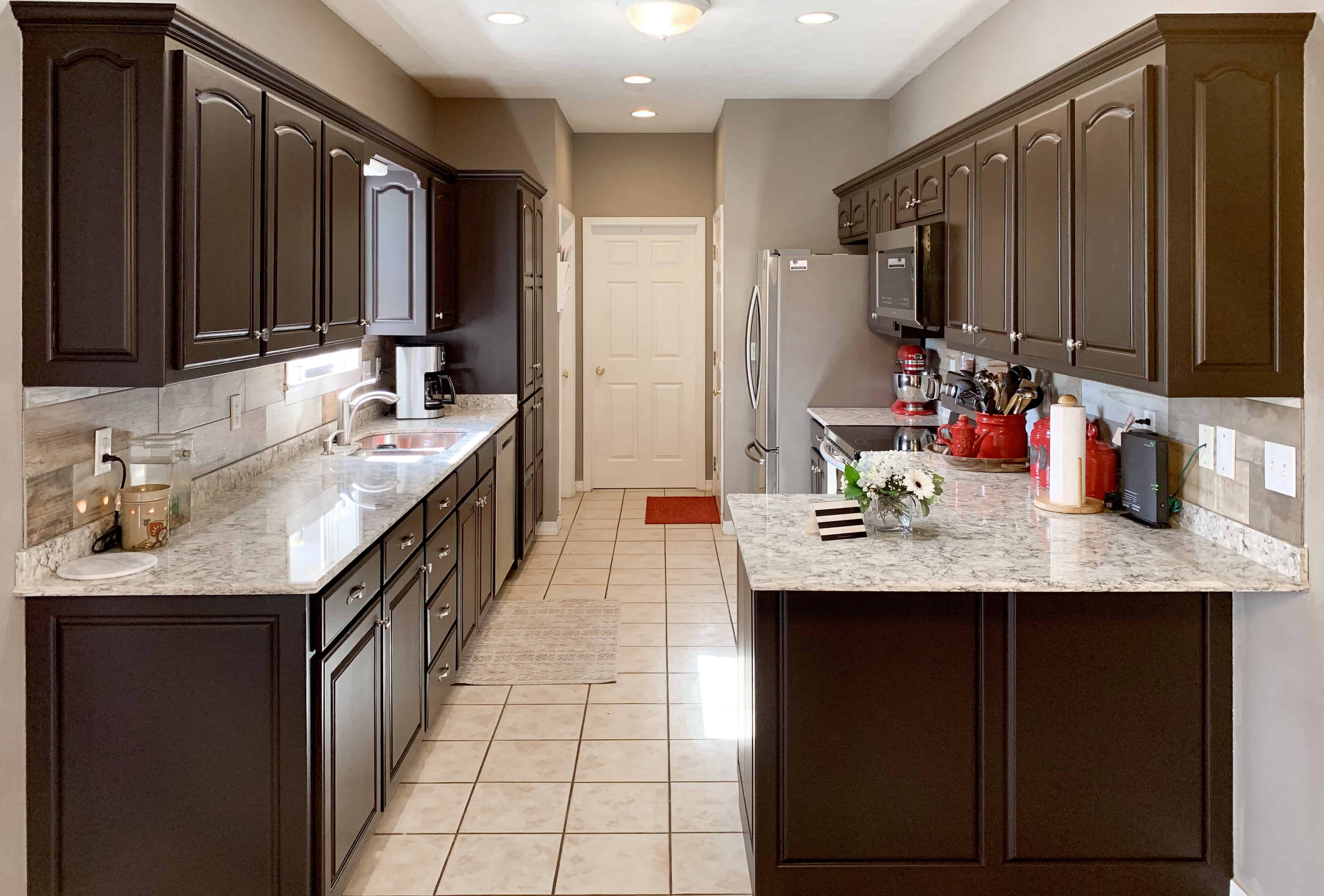Preparing the Veneer Cabinets for Painting: How To Paint Veneer Cabinets Without Sanding
Getting your veneer cabinets ready for a fresh coat of paint without sanding is totally doable, and it’s all about meticulous prep work. A clean, properly prepped surface is key to achieving a professional-looking finish that will last. This means tackling grease, grime, and any minor imperfections before you even think about breaking out the paintbrush.
Cleaning the Veneer Cabinets
Thorough cleaning is the first step to painting veneer cabinets without sanding. You need to remove all traces of grease, grime, and any old wax buildup. A degreaser is your best friend here. Use a solution of warm water and a mild dish soap, or a commercial degreaser following the product instructions. Apply the solution to the cabinet surfaces using a soft cloth or sponge, gently scrubbing to loosen dirt and grime. Rinse thoroughly with clean water and allow the cabinets to dry completely before proceeding. For stubborn grease, you might need to repeat the cleaning process. Don’t forget to clean the inside of the cabinet doors as well!
Addressing Minor Imperfections
Even with careful cleaning, you might find minor imperfections like small chips or cracks in the veneer. These need to be addressed before painting to create a smooth, even surface. Wood filler specifically designed for veneer is your go-to solution. Apply the filler sparingly using a putty knife, ensuring you fill the imperfection completely without creating excess buildup. Once the filler is dry (check the product instructions for drying times), lightly sand the area with very fine-grit sandpaper (like 220-grit) to create a smooth, flush surface. A little patience here goes a long way in achieving a professional result. Remember to wipe away any sanding dust before moving on.
Taping Off Surrounding Areas
Protecting areas surrounding the cabinets from paint splatter is crucial for a clean finish. Use high-quality painter’s tape, preferably a low-tack variety designed for delicate surfaces. Apply the tape carefully, pressing firmly to ensure a good seal. Avoid stretching the tape, as this can cause it to lift and allow paint to seep underneath. For sharp edges and corners, consider using a narrower tape width for better precision. Different tapes have different adhesive strengths; for veneer, a lower tack is better to prevent damage during removal.
Primer Selection for Veneer
| Primer Type | Adhesion | Drying Time (approx.) | Veneer Suitability |
|---|---|---|---|
| Oil-based primer | Excellent, penetrates deeply | Several hours | Suitable for most veneers, but strong odor |
| Sheen-enhancing primer | Good, smooths surface | 1-2 hours | Ideal for achieving a smooth finish |
| Water-based acrylic primer | Good, low odor | 30-60 minutes | Suitable for most veneers, easy cleanup |
| Specialty veneer primer | Excellent, formulated for veneer | Varies by product | Best option for delicate or problematic veneers |
Applying Paint to Veneer Cabinets

Painting veneer cabinets without sanding requires careful consideration of paint type and application method to achieve a smooth, durable finish. The key is to use a paint that’s designed to adhere well to smooth surfaces and employ techniques that minimize the appearance of brush strokes or other imperfections.
Paint Types for Veneer Cabinets
Choosing the right paint is crucial for a successful paint job on veneer. Both latex and oil-based paints can be used, each with its own set of advantages and disadvantages. Latex paints are water-based, making them easier to clean up and generally less toxic. However, they may not be as durable as oil-based paints, especially in high-traffic areas. Oil-based paints offer superior durability and a smoother finish, but they require mineral spirits for cleanup and have a stronger odor. For veneer cabinets, a high-quality, premium latex paint designed for adhesion is often the preferred choice due to its ease of use and lower environmental impact. A bonding primer is highly recommended with either type of paint.
Paint Application Methods, How to paint veneer cabinets without sanding
Several methods exist for applying paint to veneer cabinets, each with its own pros and cons. Brushing offers excellent control, allowing you to work around details and achieve a precise finish. However, it’s more labor-intensive and prone to brush strokes if not done carefully. Rolling is faster and covers larger areas quickly, but it can leave a textured finish if not done properly. Spraying provides the smoothest, most even finish, but requires specialized equipment and proper ventilation due to overspray. For veneer cabinets, a combination of brushing and rolling often yields the best results, using a brush for edges and details and a roller for larger surfaces.
Step-by-Step Painting Guide
- Prepare the surface: Ensure the veneer is clean, dry, and free of any grease or debris. Apply a high-quality bonding primer specifically designed for smooth surfaces, following the manufacturer’s instructions.
- Apply the first coat: Using a high-quality brush and/or roller, apply a thin, even coat of paint. Work in sections, avoiding over-application. Allow the paint to dry completely according to the manufacturer’s instructions; this typically takes several hours.
- Inspect and sand lightly (optional): Once the first coat is dry, carefully inspect the surface for any imperfections. If needed, lightly sand with very fine-grit sandpaper (220-grit or higher) to smooth out any bumps or drips. Wipe away any sanding dust with a tack cloth.
- Apply subsequent coats: Apply additional coats of paint, following the same procedure as the first coat. Two to three coats are usually sufficient for adequate coverage and durability. Allow each coat to dry completely before applying the next.
- Final inspection: After the final coat has dried, inspect the cabinets for any imperfections. If necessary, use a very fine-grit sandpaper to lightly smooth out any remaining imperfections. Wipe clean with a tack cloth.
Addressing Common Painting Issues
Brush strokes and drips are common issues when painting, especially on smooth surfaces like veneer. To prevent brush strokes, use smooth, even strokes and avoid overloading the brush or roller with paint. For drips, apply thin coats and allow each coat to dry completely before applying the next. If drips do occur, carefully sand them down once dry using fine-grit sandpaper and reapply paint to the affected area. Working in a well-ventilated area can also help prevent drips and ensure proper drying. Proper preparation, thin coats, and patience are key to achieving a professional-looking finish.
Finishing Touches and Considerations

Successfully painting veneer cabinets without sanding requires attention to detail in the final stages. Proper sealing protects your hard work and ensures a durable, long-lasting finish. Safety precautions are also crucial throughout the process to prevent accidents and health issues. Finally, understanding potential challenges and their solutions will lead to a smoother, more satisfying project.
Protective Sealants for Painted Veneer
Choosing the right sealant is key to maximizing the longevity and beauty of your newly painted cabinets. Several options offer varying levels of protection and aesthetic qualities. Consider the environment and intended use of your cabinets when making your selection.
- Polyurethane: A popular choice known for its exceptional durability, water resistance, and scratch resistance. Polyurethane creates a hard, protective layer that is ideal for high-traffic areas like kitchens and bathrooms. It’s available in various finishes, from high-gloss to matte.
- Acrylic Sealer: A water-based option that offers good protection and is easier to clean up than oil-based polyurethane. Acrylic sealers are less durable than polyurethane but still provide decent protection against moisture and minor scratches. They are often preferred for their lower odor.
- Lacquer: A fast-drying, hard finish that provides excellent protection and a high-gloss sheen. Lacquer is known for its durability but can be more challenging to apply evenly, requiring some experience. It also has a stronger odor than water-based options.
Ventilation and Safety Precautions
Proper ventilation is essential when working with paints and sealants, many of which release volatile organic compounds (VOCs). These compounds can be harmful if inhaled. Always work in a well-ventilated area, preferably outdoors or in a space with a good exhaust fan. If working indoors, open windows and doors to maximize airflow.
- Safety Equipment: Wear a respirator designed to filter VOCs. This is crucial to protect your lungs from harmful fumes. Safety glasses protect your eyes from paint splashes, and gloves prevent skin irritation from chemicals. A paint suit or old clothes you don’t mind ruining is also a good idea.
- Safety Procedures: Read and follow all instructions on paint and sealant containers. Never mix different types of paint or sealant unless specifically instructed to do so. Keep children and pets away from the work area. Dispose of all materials responsibly according to local regulations.
Challenges and Solutions for Painting Veneer Without Sanding
Painting veneer without sanding presents unique challenges. However, with the right approach and techniques, you can achieve a professional-looking finish.
- Poor Paint Adhesion: Veneer’s smooth surface can make it difficult for paint to adhere properly. Using a high-quality primer specifically designed for smooth surfaces, such as a bonding primer, is crucial. This primer will create a better surface for the paint to grab onto.
- Uneven Surface: Minor imperfections in the veneer can show through the paint. Applying multiple thin coats of paint, allowing each coat to dry completely before applying the next, helps to minimize this. Lightly sanding *between* coats with a very fine grit sandpaper (if absolutely necessary) can also improve the finish but is generally avoided in no-sanding methods.
- Brush Strokes Showing: Using a high-quality brush or roller with a smooth finish will minimize brush strokes. Apply paint in long, even strokes in one direction. Using a paint sprayer can provide a smoother, more even finish, but requires more setup and cleanup.
- Bleeding Through: Darker colors or stains on the veneer can bleed through the paint. Applying a stain-blocking primer before painting is essential to prevent this. This creates a barrier between the veneer and the paint.
